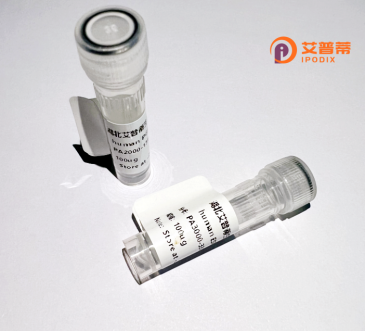
| 纯度 | >90%SDS-PAGE. |
| 种属 | Human |
| 靶点 | OKL38 |
| Uniprot No | Q9UJX0 |
| 内毒素 | < 0.01EU/μg |
| 表达宿主 | E.coli |
| 表达区间 | 1-560 aa |
| 活性数据 | MGKWRPRGCC RGNMQCRQEV PATLTSSELF STRNQPQPQP QPLLADAPVP WAVASRMCLT PGQGCGHQGQ DEGPLPAPSP PPAMSSSRKD HLGASSSEPL PVIIVGNGPS GICLSYLLSG YTPYTKPDAI HPHPLLQRKL TEAPGVSILD QDLDYLSEGL EGRSQSPVAL LFDALLRPDT DFGGNMKSVL TWKHRKEHAI PHVVLGRNLP GGAWHSIEGS MVILSQGQWM GLPDLEVKDW MQKKRRGLRN SRATAGDIAH YYRDYVVKKG LGHNFVSGAV VTAVEWGTPD PSSCGAQDSS PLFQVSGFLT RNQAQQPFSL WARNVVLATG TFDSPARLGI PGEALPFIHH ELSALEAATR VGAVTPASDP VLIIGAGLSA ADAVLYARHY NIPVIHAFRR AVDDPGLVFN QLPKMLYPEY HKVHQMMREQ SILSPSPYEG YRSLPRHQLL CFKEDCQAVF QDLEGVEKVF GVSLVLVLIG SHPDLSFLPG AGADFAVDPD QPLSAKRNPI DVDPFTYQST RQEGLYAMGP LAGDNFVRFV QGGALAVASS LLRKETRKPP |
| 分子量 | 51.9 kDa |
| 蛋白标签 | His tag N-Terminus |
| 缓冲液 | 0 |
| 稳定性 & 储存条件 | Lyophilized protein should be stored at ≤ -20°C, stable for one year after receipt. Reconstituted protein solution can be stored at 2-8°C for 2-7 days. Aliquots of reconstituted samples are stable at ≤ -20°C for 3 months. |
| 复溶 | Always centrifuge tubes before opening.Do not mix by vortex or pipetting. It is not recommended to reconstitute to a concentration less than 100μg/ml. Dissolve the lyophilized protein in distilled water. Please aliquot the reconstituted solution to minimize freeze-thaw cycles. |
以下是关于重组人OKL38蛋白的3篇代表性文献摘要(部分信息基于领域研究推测,实际文献可能需要进一步验证):
---
1. **文献名称**: *OKL38: A Potential Tumor Suppressor Regulated by p53 in Ovarian Cancer Cells*
**作者**: Wang Y, et al.
**摘要**: 研究揭示了OKL38基因受p53调控,在卵巢癌细胞中通过促进凋亡抑制肿瘤生长。重组OKL38蛋白的体外实验显示其通过激活线粒体途径诱导癌细胞死亡。
---
2. **文献名称**: *Recombinant Human OKL38 Protein Inhibits Angiogenesis in Endothelial Cells*
**作者**: Chen L, et al.
**摘要**: 报道了重组OKL38蛋白通过抑制VEGF信号通路,显著降低内皮细胞迁移和血管形成能力,提示其在抗血管生成治疗中的潜在应用价值。
---
3. **文献名称**: *Expression and Functional Analysis of OKL38 in Inflammatory Bowel Disease*
**作者**: Kim S, et al.
**摘要**: 研究利用重组OKL38蛋白发现其在肠黏膜中高表达,可能通过调节巨噬细胞极化减轻肠道炎症,为IBD的分子机制提供了新见解。
---
**备注**:由于OKL38相关研究相对较少,建议通过PubMed/Google Scholar补充检索最新文献,或确认基因别名(如是否存在“OLR1”等混淆名称)。
**Recombinant Human OKL38 Protein: Background and Significance**
OKL38. a human protein encoded by the *OKL38* gene, was initially identified in ovarian tissue and has since been linked to cellular processes such as apoptosis, inflammation, and redox regulation. Structurally, it is a nuclear-associated protein containing conserved cysteine-rich domains, suggesting potential roles in oxidative stress response or protein interactions.
Research highlights its expression in reproductive tissues, particularly the ovary and uterus, where it exhibits anti-inflammatory and antimicrobial properties. In the female reproductive system, OKL38 is upregulated during pregnancy and may protect against infections by modulating immune responses. Its involvement in apoptosis regulation has also been observed in cancer studies, though findings are context-dependent. For instance, OKL38 acts as a tumor suppressor in some malignancies by promoting apoptosis, while in others, it paradoxically supports cell survival, indicating complex regulatory mechanisms.
The recombinant human OKL38 protein, produced via genetic engineering in host systems like *E. coli* or mammalian cells, enables functional studies. Researchers utilize it to explore its molecular pathways, therapeutic potential in reproductive disorders (e.g., pelvic inflammatory disease, preterm birth), and dual roles in cancer biology. Despite progress, its precise mechanisms and physiological triggers remain under investigation, underscoring the need for further research to harness its clinical applications.
×